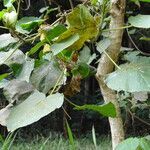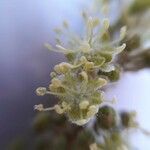A tree. It grows 25 m high. It loses its leaves for a short time. The crown is rounded and open with spreading branches. The bark is pale grey and finely cracked. The leaves are large and green. They turn orange before they fall. They are oval with a rounded base and taper to the tip. There can be teeth along the edge. The leaves are 5-19 cm long by 4015 cm wide. The leaves are on long stalks crowded at the ends of small branches. The flowers are yellow to white and have a sweet scent. The male and female flowers are on separate shoots. They are in erect spikes. The male flowering shoots are 25 cm long. The female shoots are 10 cm long. The fruit are green when young. They are on drooping spikes 10 cm long. They have 3 lobes.
Female flowers: pedicels 2–5 mm long, not or scarcely extending in fruit, stout, densely stellate-pubescent; sepals 5, 3–3.5 × 1.5–2 mm, ovate-lanceolate, evenly stellate-lepidote without, sparingly stellate-pubescent within, grey-green; petals 0 or 5, 0.5–1 mm long, linear to subulate, subglabrous; disk 5-lobed, the lobes truncate, pubescent; ovary 2 mm in diameter, trigonous or quadrangular, densely lepidote; styles 3–4, 3 mm long, spreading, 2-partite with the segments filiform-linear, minutely puberulous.
Leaf blades 6–18 × 4–14 cm, ovate, acuminate at the apex, shallowly crenate-serrate to subentire on the margins, cordate or subcordate at the base with a pair of shortly stipitate to subsessile basal discoid glands on the lower surface, chartaceous, sparingly appressed stellate-pubescent to fimbriate-lepidote above, and sparingly to densely so or patent stellate-tomentose beneath; 5–7-nerved from the base, lateral nerves in 4–9 pairs, ± prominent beneath.
Male flowers: pedicels 0.5–1 cm long; sepals 5, 3 × 2–2.5 mm, ovate, stellate-lepidote without, pubescent within, pale green; petals 5, 3–3.5 × 1.5–2 mm, oblanceolate-oblong, subglabrous without, villous within and on the margin, pale creamy-yellow in colour; disk glands rounded, pilose; stamens 15–20, filaments 4 mm long, villous below, anthers c. 1 mm long; receptacle densely villous.
Young twigs, petioles and inflorescence axes densely, evenly or sparingly greyish appressed or patent stellate-pubescent, later glabrescent and becoming dark grey-brown and lenticellate.
Racemes up to 35 cm long, terminal, usually androgynous, sometimes male or female; bracts shorter than the stipules but otherwise resembling the stipules.
Fruits 0.8–1 × 0.8–1.5 cm, trilobate or quadrilobate, loculicidal or septicidal, densely to evenly scurfily stellate-pubescent, pale greyish-green.
A tree up to 30 m tall, dioecious or sometimes monoecious; crown much-branched, spreading, rounded.
Bark smooth to closely reticulate, pale grey or greyish-brown, slightly corky.
Seeds 7 × 4 mm, ellipsoid, rugulose, grey; caruncle 4.5 × 4 mm, waxy.
Stipules 5–7 mm long, linear to filiform-setaceous, soon falling.
Fruit slightly 3-lobed, about 1/2 in. diam.
A tree, in savannah, up to 30–50 ft high
Bole up to 1.8 m in circumference.
Petioles 3–12 cm long.
Flowers fragrant.
Flowers white



